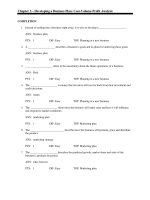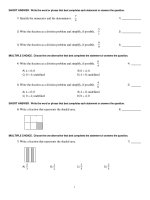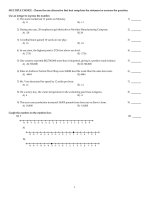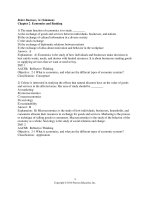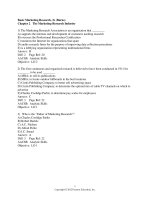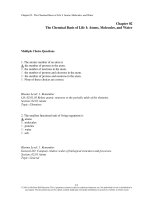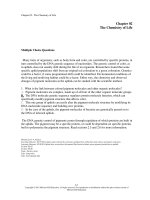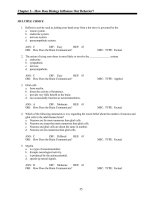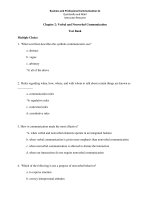Nutrition for healthy living 3rd edition schiff test bank
Bạn đang xem bản rút gọn của tài liệu. Xem và tải ngay bản đầy đủ của tài liệu tại đây (217.99 KB, 34 trang )
Chapter 02 - Evaluating Nutrition Information
Chapter 02
Evaluating Nutrition Information
Multiple Choice Questions
1. A group of registered dietitians is planning to conduct a scientific study to investigate the
effects of eating honey on school-age children's behavior. At first, the researchers will
A. analyze the hypothesis.
B. make observations.
C. identify relationships between variables.
D. gather data.
Bloom's Level: 1. Remember
Learning Outcome: 2.02 Explain the basic steps of the scientific method.
Section: 2.01
Topic: Nutrition Basics
2. A medical researcher reads an article in "Today's Health-Conscious Woman" magazine
about the benefits of using the phytochemical capsaicin to treat knee pain. She asks 10 people
with arthritic knees to rub a cream that contains the phytochemical on their knee joints for two
weeks. At the end of the two weeks, the researcher asks the subjects whether their knee pain
improved, stayed about the same, or worsened during the treatment period. After collecting
responses from the people, the researcher reports the results of her study during a popular TV
show that is hosted by a doctor. Based on this information, which of the following statements
is false?
A. This study's design followed conventional scientific methodology for research involving
human subjects.
B. The researcher failed to review scientific literature regarding the use of capsaicin to treat
knee pain.
C. The number of subjects enrolled in the study was not large enough to reduce the
possibility that the results occurred by chance.
D. The researcher did not divide the subjects of her study into control and treatment groups.
Bloom's Level: 4. Analyze
Learning Outcome: 2.02 Explain the basic steps of the scientific method.
Section: 2.01
Topic: Nutrition Basics
2-1
Chapter 02 - Evaluating Nutrition Information
3. A nutrition scientist has heard anecdotes about the usefulness of taking megadoses of
vitamin C to prevent the common cold. The researcher decides to test the hypothesis that
consuming such large doses of vitamin C are an effective way to prevent colds. He provides
dietary supplements that contain 10 times the physiological dose of vitamin C in each pill to a
group of 12 adults, and he instructs the people to take one pill daily for a year. After a year,
the scientist asks the subjects to recall the number and duration of colds they experienced
during the previous 12 months. After collecting and analyzing the subjects' responses, the
researcher determines that taking megadoses of vitamin C each day is an effective way to
prevent cold infections. Based on this information, which of the following statements is true?
A. This study's design followed conventional scientific methodology for research involving
epidemiological studies.
B. The results could have occurred by chance because there were not enough subjects
involved in the research.
C. After collecting and analyzing data from the subjects, the researcher should submit his
study design to a human subjects review committee for their approval.
D. None of these is correct.
Bloom's Level: 4. Analyze
Learning Outcome: 2.02 Explain the basic steps of the scientific method.
Section: 2.01
Topic: Nutrition Basics
4. A group of scientists conducts a scientific study to investigate dietary factors that influence
the development of obesity. Which of the following activities is not likely to be a component
of their research efforts?
A. Making observations and formulating a hypothesis
B. Submitting an article describing the study to a peer-reviewed journal
C. Posting findings at the main researcher's Internet web site
D. Collecting data and analyzing results
Bloom's Level: 1. Remember
Learning Outcome: 2.02 Explain the basic steps of the scientific method.
Section: 2.01
Topic: Nutrition Basics
2-2
Chapter 02 - Evaluating Nutrition Information
5. According to the observations of a nutrition scientist, laboratory mice are healthier when
their diet contains physiological levels of vitamin D than when their diet lacks
the micronutrient. The scientist hypothesizes that mice will be less likely to develop cancer
when they consume a diet that supplies megadoses of vitamin D. Based on this information,
the scientist is ready to
A. plan a retrospective study involving at least 5,000 laboratory mice to test the vitamin D
and cancer hypothesis in mice.
B. design a double-blind study to test the vitamin D and cancer hypothesis in mice.
C. conduct a controlled laboratory experiment to test the vitamin D and cancer hypothesis in
mice.
D. set up an experimental epidemiological study to test the vitamin D and cancer hypothesis
in mice.
Bloom's Level: 3. Apply
Learning Outcome: 2.02 Explain the basic steps of the scientific method.
Section: 2.01
Topic: Nutrition Basics
6. A medical researcher observes that 6-year-old children prefer to drink chocolate-flavored
whole milk than plain whole milk. The researcher hypothesizes that 6-year-old children can
reduce their intakes of animal fat by being offered chocolate-flavored fat-free milk instead of
the chocolate-flavored whole milk. Based on this information, the scientist is ready to take the
next step, which is
A. conduct a retrospective study involving at least 1,000 6-year-old children who drink
chocolate milk.
B. conduct a double-blind study to test the willingness of children to drink chocolate-flavored
fat-free milk.
C. contact the parents of several hundred 6-year-old children who attend three local
elementary schools and invite them to enroll their children in the study.
D. design the study and submit the design to his institution's human subjects review
committee.
Bloom's Level: 3. Apply
Learning Outcome: 2.02 Explain the basic steps of the scientific method.
Section: 2.01
Topic: Nutrition Basics
2-3
Chapter 02 - Evaluating Nutrition Information
7. Researchers at a major American university plan a scientific study to investigate lifestyle
factors that contribute to heart disease. Which of the following activities is likely to be a
component of their research efforts?
A. Obtaining FDA and FTC approval to conduct research on human subjects
B. Submitting an article describing the study to a peer-reviewed journal
C. Posting significant findings at the main researcher's Internet web site
D. None of these is correct.
Bloom's Level: 1. Remember
Learning Outcome: 2.02 Explain the basic steps of the scientific method.
Section: 2.01
Topic: Nutrition Basics
8. Scientists enroll 500 healthy adults in a study and collect dietary and other lifestyle
information about the group. After 6 years, the scientists determine that study participants
who ate at least 5 servings of fruits and vegetables daily were less likely to develop high
blood pressure than participants who ate fewer than 5 servings of these foods daily. This study
is an example of a(n) ____ study.
A. prospective
B. nutritive
C. retrospective
D. introspective
Bloom's Level: 2. Understand
Bloom's Level: 4. Analyze
Learning Outcome: 2.02 Explain the basic steps of the scientific method.
Section: 2.01
Topic: Nutrition Basics
2-4
Chapter 02 - Evaluating Nutrition Information
9. A scientist adds 5 mcg of the mineral cadmium to the daily diet of 100 4-week-old
laboratory mice. After twelve weeks, the researcher weighs and takes blood samples from
each mouse. According to her findings, the mice lost weight during the 12-week period and
they have abnormal levels of certain hormones in their blood. Based on this information and
your knowledge of scientific research, what would you tell the researcher about her
findings?
A. Her results are very interesting and she should report her findings to nutrition scientists, so
they can repeat her study and confirm the results.
B. The findings are not meaningful or valid because of the way she designed her study.
C. She needs to conduct more tests on the animals' blood, because her findings are
incomplete.
D. The findings need to be summarized in a research article for submission to a peerreviewed nutrition journal.
Bloom's Level: 4. Analyze
Learning Outcome: 2.03 Explain the importance of having controls when performing experiments.
Section: 2.01
Topic: Nutrition Basics
10. A nutrition researcher adds 30 mg of the mineral iron to the daily diet of 50 4-week-old
laboratory mice. After ten weeks, the scientist takes blood samples from each mouse.
According to his findings, the mice developed abnormal levels of certain enzymes in their red
blood cells. Based on this information and your knowledge of scientific research, what would
you tell him?
A. He should report his findings to other nutrition scientists, so they can repeat his study and
confirm the results.
B. He should call a press conference and report his findings to the public, so they can avoid
consuming excess iron.
C. He should consider his findings as an observation and redesign the study to include a
control group.
D. He should prepare a research article that describes his study and its results for submission
to a peer-reviewed
nutrition journal.
Bloom's Level: 4. Analyze
Learning Outcome: 2.03 Explain the importance of having controls when performing experiments.
Section: 2.01
Topic: Nutrition Basics
2-5
Chapter 02 - Evaluating Nutrition Information
11. Over a 2-year period, a team of scientists records the eating behaviors and physical
activity patterns of a group of healthy 8-year-old children to determine whether these factors
are associated with weight gain. This study is an example of a(n) ____ study.
A. case-control
B. retrospective
C. prospective
D. in-vitro
Bloom's Level: 2. Understand
Learning Outcome: 2.02 Explain the basic steps of the scientific method.
Section: 2.01
Topic: Nutrition Basics
12. A group of nutrition researchers interviews 100 adults who have chronic high blood
pressure to determine whether there is an association between consuming diets low in calcium
during adolescence and developing high blood pressure in adulthood. This study is an
example of a ____ study.
A. case-control
B. retrospective
C. prospective
D. macrosomatic
Bloom's Level: 2. Understand
Learning Outcome: 2.02 Explain the basic steps of the scientific method.
Section: 2.01
Topic: Nutrition Basics
13. Which of the following kinds of studies would be the best to use when designing a
scientific investigation to determine whether there is an association between consuming diets
high in sodium during adolescence and developing high blood pressure in adulthood?
A. Single-blind study
B. Experimental study
C. Double-blind study
D. Observational study
Bloom's Level: 3. Apply
Learning Outcome: 2.01 Define terms, including anecdote, variable, epidemiology, placebo, placebo effect, peer review, and quackery.
Section: 2.01
Topic: Nutrition Basics
2-6
Chapter 02 - Evaluating Nutrition Information
14. A nutrition researcher would like to determine whether women who take fish oil
supplements during pregnancy give birth to babies who score higher on basic intelligence
tests when they are 5 years of age than the 5-year old children that were born to women who
did not take the fish oil supplements during pregnancy. This kind of research is a _____ study.
A.
B.
C.
D.
double-blind
prospective
case-control
None of these is correct.
Bloom's Level: 4. Analyze
Learning Outcome: 2.02 Explain the basic steps of the scientific method.
Section: 2.01
Topic: Nutrition Basics
15. Which of the following kinds of studies would be the best to use to identify lifestyle
factors that may be related to the development of liver cancer in an adult population?
A. Single-blind study
B. Experimental study
C. Retrospective study
D. Double-blind study
Bloom's Level: 3. Apply
Learning Outcome: 2.02 Explain the basic steps of the scientific method.
Section: 2.01
Topic: Nutrition Basics
16. Scientists who investigate lifestyle factors that influence the prevalence of obesity among
different population groups are conducting a(n) ____ study.
A. epidemiological
B. technological
C. pathological
D. in-vitro
Bloom's Level: 2. Understand
Learning Outcome: 2.02 Explain the basic steps of the scientific method.
Section: 2.01
Topic: Nutrition Basics
2-7
Chapter 02 - Evaluating Nutrition Information
17. Which of the following kinds of studies would be the best to use when investigating
whether cigarette smoking influences weight gain?
A. Cohort
B. Single-blind
C. Double-blind
D. Conventional
Bloom's Level: 2. Understand
Learning Outcome: 2.02 Explain the basic steps of the scientific method.
Section: 2.01
Topic: Nutrition Basics
18. Scientists in a Central American country are studying factors that may be associated with
delayed physical growth among a group of low-income children. The children live in a region
of the nation that has high levels of lead in drinking water. This study is an example of a(an)
____ study.
A. epidemiological
B. uncontrollable
C. introspective
D. conventional
Bloom's Level: 3. Apply
Learning Outcome: 2.02 Explain the basic steps of the scientific method.
Section: 2.01
Topic: Nutrition Basics
19. Scientists would like to conduct a study to identify lifestyle factors that are associated
with delayed physical growth among a group of low-income American children. Which of the
following research designs would be the best for the researchers to use when designing their
study?
A. Human in-vivo experimental
B. Epidemiological
C. Double-blind
D. Interventional
Bloom's Level: 3. Apply
Learning Outcome: 2.01 Define terms, including anecdote, variable, epidemiology, placebo, placebo effect, peer review, and quackery.
Section: 2.01
Topic: Nutrition Basics
2-8
Chapter 02 - Evaluating Nutrition Information
20. A group of scientists would like to determine lifestyle factors that are associated with the
development of asthma among American children. Based on this information, the researchers
should design a (an) _____ study.
A. conventional
B. in-vivo
C. double-blind
D. epidemiological
Bloom's Level: 3. Apply
Learning Outcome: 2.02 Explain the basic steps of the scientific method.
Section: 2.01
Topic: Nutrition Basics
21. Generally, epidemiological studies
A. establish causation without experimentation.
B. prove positive correlations.
C. cannot determine cause-and-effect relationships.
D. involve in-vitro experimentation.
Bloom's Level: 1. Remember
Learning Outcome: 2.02 Explain the basic steps of the scientific method.
Section: 2.01
Topic: Nutrition Basics
22. Derek takes protein supplements before and after his workouts. He told his workout
partner that he became 200% stronger within a couple of months after he added the
supplements to his diet. His report about the effects of the supplements is an example of a(an)
A.
B.
C.
D.
factoid.
anecdote.
variable.
case report.
Bloom's Level: 2. Understand
Learning Outcome: 2.01 Define terms, including anecdote, variable, epidemiology, placebo, placebo effect, peer review, and quackery.
Section: 2.01
Topic: Nutrition Basics
2-9
Chapter 02 - Evaluating Nutrition Information
23. Zack takes 500 mg of vitamin C daily. He advises his friends to take vitamin C
supplements because, he claims, the vitamin protects him from cold viruses. His claim about
the usefulness of the vitamin is an
A. in-vivo report.
B. in-vitro assumption.
C. introspection.
D. anecdote.
Bloom's Level: 2. Understand
Learning Outcome: 2.01 Define terms, including anecdote, variable, epidemiology, placebo, placebo effect, peer review, and quackery.
Section: 2.01
Topic: Nutrition Basics
24. Emily has brittle fingernails that crack and split easily. Emily's mother advises her
daughter to take gelatin pills 3 times/day, because she has heard the practice strengthens
fingernails. The mother's nutrition-related advice about the benefit of taking gelatin pills is an
example of a(n)
A. hypothesis.
B. testimonial.
C. anecdote.
D. placebo.
Bloom's Level: 2. Understand
Learning Outcome: 2.01 Define terms, including anecdote, variable, epidemiology, placebo, placebo effect, peer review, and quackery.
Section: 2.01
Topic: Nutrition Basics
25. Dylan takes garlic pills to lower his blood cholesterol level, and he recommends the pills
to his friends, because he thinks the supplement is helpful. Dylan's nutrition-related advice to
his friends is an example of a(an)
A. introspection.
B. subjective bias.
C. peer review.
D. anecdote.
Bloom's Level: 2. Understand
Learning Outcome: 2.01 Define terms, including anecdote, variable, epidemiology, placebo, placebo effect, peer review, and quackery.
Section: 2.01
Topic: Nutrition Basics
2-10
Chapter 02 - Evaluating Nutrition Information
26. Having a control group enables researchers to
A. provide specific treatments to participants of the group.
B. compare findings of the control group with those of the experimental group.
C. avoid using harmful interventions when testing control subjects' responses.
D. explore possible hypotheses for future research efforts.
Bloom's Level: 1. Remember
Learning Outcome: 2.03 Explain the importance of having controls when performing experiments.
Section: 2.01
Topic: Nutrition Basics
27. Phil is a participant in a study designed to examine the effects of taking a dietary
supplement on muscle tissue development. Phil suspects he is in the experimental group,
because he is certain his muscles are bigger and stronger as a result of taking the product
supplied by the researchers. When the study is completed, Phil learns that he did not receive
the dietary supplement. Phil thinks the researchers made a mistake—he is certain his muscle
mass increased while he took the supplement. According to this information, Phil's belief that
his physical condition improved while he participated in the study is an example of
A. the placebo effect.
B. an anecdotal report.
C. human subject bias.
D. participant fatigue.
Bloom's Level: 2. Understand
Learning Outcome: 2.01 Define terms, including anecdote, variable, epidemiology, placebo, placebo effect, peer review, and quackery.
Section: 2.01
Topic: Nutrition Basics
28. The host of a radio program makes a "red flag" claim about a nutrition-related product,
because the claim is generally an indication that the information about the product is
unreliable. The radio program host said,
A. "According to the FDA, this product is classified a dietary supplement, because it contains
vitamins."
B. "All ingredients in this product have been scientifically tested and clinically proven."
C. "This product contains sugar and certain artificial color and flavor additives."
D. "The ingredients in this product are listed on the label."
Bloom's Level: 3. Apply
Learning Outcome: 2.05 Describe how to identify questionable sources of nutrition information.
Section: 2.02
Topic: Nutrition Basics
2-11
Chapter 02 - Evaluating Nutrition Information
29. A physician who hosts a popular TV show makes several nutrition related claims during
one of the programs. He states that vitamin C is an essential nutrient; niacin cures pellagra; a
type of bacterium is often associated with the development of stomach ulcers; and dietary
supplements that contain the herb kava have been clinically proven to cure migraine
headaches. Which of the doctor's claims is a "red flag" of unreliable information?
A. Kava cures migraine headaches.
B. A bacterium is often involved in the development of stomach ulcers.
C. Niacin cures pellagra.
D. Vitamin C is an essential nutrient.
Bloom's Level: 4. Analyze
Learning Outcome: 2.05 Describe how to identify questionable sources of nutrition information.
Section: 2.02
Topic: Nutrition Basics
30. An article in a popular men's magazine includes several health-related claims, such as
regular exercise prevents stomach ulcers; herbal supplements are essential for optimal health;
and niacin cures pellegra. Which of these claims is supported by scientific evidence?
A. Herbal supplements are essential for optimal health.
B. Niacin cures pellegra.
C. Regular exercise prevents stomach ulcers.
D. None of these is correct.
Bloom's Level: 4. Analyze
Learning Outcome: 2.05 Describe how to identify questionable sources of nutrition information.
Section: 2.02
Topic: Nutrition Basics
31. A physician who hosts a popular TV show makes several nutrition-related claims during
one of the programs. According to the physician, melatonin may be effective for treating
certain sleep disorders; white sugar causes stomach ulcers; and niacin cures pellagra. Which
of the doctor's claims is a "red flag" for unreliable information?
A. Melatonin may be a useful treatment for certain sleep disorders.
B. Niacin cures pellagra.
C. White sugar causes stomach ulcers.
D. All of these are correct.
Bloom's Level: 3. Apply
Learning Outcome: 2.05 Describe how to identify questionable sources of nutrition information.
Section: 2.01
Topic: Nutrition Basics
2-12
Chapter 02 - Evaluating Nutrition Information
32. Bonita is a biochemist for a manufacturer that uses tomato seed extract to make a dietary
supplement. According to the results of her research, people who take the dietary supplements
do not report a reduction in the number of upper respiratory tract infections they experience,
including the common cold. However, Bonita's boss does not encourage her to publish the
findings in scientific literature. The boss's lack of enthusiasm for spreading the news about
Bonita's research is an example of
A. whistleblowing.
B. denial.
C. quackery.
D. bias.
Bloom's Level: 2. Understand
Learning Outcome: 2.04 Define research bias.
Section: 2.01
Topic: Nutrition Basics
33. Which of the following observations is an example of an inverse correlation?
A. When members of a population increase their consumption of milk and milk products,
their risk of bone fractures decreases.
B. As children increase their physical activity level, they develop greater muscle mass than
children who are less active.
C. When pregnant women gain more weight than average, they are more likely to give birth
to babies who are heavier than average.
D. None of these is correct.
Bloom's Level: 3. Apply
Section: 2.01
Topic: Nutrition Basics
2-13
Chapter 02 - Evaluating Nutrition Information
34. Which of the following observations is an example of a positive correlation?
A. When members of a population consume fewer fruits and vegetables, their risk of high
blood pressure increases.
B. When a group of children increases their physical activity levels, the percentage of the
children who contract cold infections decreases.
C. When women gain less weight than average during pregancy, the birthweights of their
babies tend to be lower than average.
D. When a population's intake of green tea increases, the percentage of lung cancer cases in
that population decreases.
Bloom's Level: 3. Apply
Section: 2.01
Topic: Nutrition Basics
35. Which of the following observations is an example of an inverse correlation?
A. When population increases its daily consumption of whole grain products, the population's
frequency of daily bowel movements increases.
B. Children who consume 3 cups of vitamin D milk daily develop stronger bones than
children who drink fewer than 3 cups of vitamin D milk each day.
C. Women who smoke 5 or more cigarettes each day during pregnancy are more likely to
give birth to underweight babies than women who smoke fewer than 5 cigarettes a day during
pregnancy.
D. As a population's intake of beta carotene increases, the population's tissue levels of
vitamin A increase.
Bloom's Level: 4. Analyze
Section: 2.01
Topic: Nutrition Basics
2-14
Chapter 02 - Evaluating Nutrition Information
36. Which of the following observations is an example of a positive correlation?
A. When teenage girls increase their intake of iron-rich foods, the percentage of the girls who
have iron-deficiency decreases.
B. When a population consumes more fruits and vegetables, the percentage of people in that
population with scurvy decreases.
C. When older adults increase their daily intake of vitamin D, the percentage of the adults
that develops infections decreases.
D. When a group of 6-year-old children increase their physical activity level to 60 minutes a
day, the percentage of the children in the group who lose excess body fat increases.
Bloom's Level: 3. Apply
Section: 2.01
Topic: Nutrition Basics
37. Which of the following observations is an example of a positive correlation?
A. When a population's vitamin D intake decreases, the percentage of people in the
population that have healthy immune systems decreases.
B. When a population's intake of plant foods decreases, the percentage of obese people in that
population increases.
C. When a population's level of vitamin C in white blood cells increases, the percentage of
people in the population who develop scurvy decreases.
D. When a population's level of physical activity increases, the percentage of people who
develop heart disease decreases.
Bloom's Level: 2. Understand
Learning Outcome: 2.01 Define terms, including anecdote, variable, epidemiology, placebo, placebo effect, peer review, and quackery.
Section: 2.01
Topic: Nutrition Basics
2-15
Chapter 02 - Evaluating Nutrition Information
38. Scientists study 200 adults who have type 2 diabetes and 200 adults who have similar
characteristics but do not have the disease. For 18 months, the researchers collect lifestyle
information on all the study participants. According to the study's findings, the adults with
type 2 diabetes were 25% less physically active than their counterparts who did not have type
2 diabetes. This is an example of a(n) _____ study.
A. inverse relationship
B. anecdotal
C. prospective
D. case-control
Bloom's Level: 2. Understand
Section: 2.01
Topic: Nutrition Basics
39. A researcher wants to identify lifestyle factors that increase the risk of stomach cancer in
men. His study design involves enrolling 250 adult men who have stomach cancer and 250
men who are cancer-free but have similar characteristics and backgrounds as the men who
have stomach cancer. The researcher collects and analyzes information about each
participant's lifestyle. Based on this information, what kind of study is the researcher
conducting?
A. Case-control
B. Cohort
C. Experimental
D. In-vivo
Bloom's Level: 4. Analyze
Learning Outcome: 2.01 Define terms, including anecdote, variable, epidemiology, placebo, placebo effect, peer review, and quackery.
Section: 2.01
Topic: Nutrition Basics
2-16
Chapter 02 - Evaluating Nutrition Information
40. Which of the following observations is an example of a negative (an inverse) correlation?
A. When a group of adults reduces their intake of fruits and vegetables, the percentage of
people in the group who have high blood pressure increases.
B. When a group of people increases their physical activity levels, the percentage of people
in the group with type 2 diabetes decreases.
C. When a group of older adults increases their intake of high-fiber foods, the percentage of
people in the group who develop cancer decreases.
D. All of these are correct.
Bloom's Level: 3. Apply
Section: 2.01
Topic: Nutrition Basics
41. A group of scientists suspects that certain dietary practices are partially responsible for
different rates of hypertension among different ethnic/racial groups. To test their hypothesis,
the researchers examine data concerning the different population groups' hypertension rates
and their past dietary practices. This research is a(n) _____ study.
A. retrospective
B. case-control
C. prospective
D. hypothetical
Bloom's Level: 2. Understand
Learning Outcome: 2.01 Define terms, including anecdote, variable, epidemiology, placebo, placebo effect, peer review, and quackery.
Section: 2.01
Topic: Nutrition Basics
2-17
Chapter 02 - Evaluating Nutrition Information
42. Scientists conduct a study in which 100 adults with chronic diarrhea are divided into 2
groups of 50 people. One group is given a supply of yogurt that contains a certain kind of
bacteria and the other group is given yogurt that is bacteria free. The study's participants and
researchers do not know which group of subjects has the bacteria in the yogurt and which
group does not. The scientists instruct the participants to eat the entire 8 ounces of yogurt
once a day for a month and record the their bowel habits. This is an example of a(n) ____
study.
A. introspective
B. double-blind
C. uncontrolled
D. hypothetical
Bloom's Level: 2. Understand
Section: 2.01
Topic: Nutrition Basics
43. A group of researchers wants to determine whether certain dietary factors are associated
with the risk of attention deficit hyperactivity disorder (ADHD). The scientists follow a group
of 500 healthy newborn babies for 10 years and collect health information as well as dietary
practices for each child. At the end of the study period, the scientists analyze the data for
correlations between the children's dietary practices and their likelihood of being diagnosed
with ADHD. This is an example of a _____ study.
A. retrospective
B. factorial
C. prospective
D. hypothetical
Bloom's Level: 2. Understand
Section: 2.01
Topic: Nutrition Basics
2-18
Chapter 02 - Evaluating Nutrition Information
44. Scientists are conducting research to determine the effects of an herbal supplement on the
emotional health of 100 adults. The researchers give pills that contain the herb to 50 of the
subjects subjects. The remaining subjects receive pills that look, smell, and taste like the
herbal pills but contain no active ingredients. Neither the researchers nor the subjects know
whether their pills contain the herb. This is an example of a(n) ______ study.
A. intervention
B. double-blind
C. case-control
D. None of these is correct.
Bloom's Level: 2. Understand
Section: 2.01
Topic: Nutrition Basics
45. Researchers are conducting a study to determine the effects of vitamin C on the human
immune system. The study involves providing pills that contain vitamin C to one group of
human subjects and pills that do not contain vitamin C or other active ingredients to another
group of people. The pills that do not contain the vitamin are
A. antidotes.
B. supplements.
C. placebos.
D. probiotics.
Bloom's Level: 1. Remember
Learning Outcome: 2.01 Define terms, including anecdote, variable, epidemiology, placebo, placebo effect, peer review, and quackery.
Section: 2.01
Topic: Nutrition Basics
46. Researchers are conducting a study to determine the effects of vitamin D supplements on
the human immune system. The study involves providing pills that contain vitamin D to one
group of human subjects and pills that do not contain the vitamin or other active ingredients to
another group of people. The pills that do not contain vitamin D are
A. placebos.
B. antidotes.
C. distractors.
D. interventions.
Bloom's Level: 1. Remember
Learning Outcome: 2.01 Define terms, including anecdote, variable, epidemiology, placebo, placebo effect, peer review, and quackery.
Section: 2.01
Topic: Nutrition Basics
2-19
Chapter 02 - Evaluating Nutrition Information
47. Researchers are conducting a study to determine the effects of zinc supplements on the
human immune system. The study involves providing pills that contain zinc to one group of
human subjects and pills that do not contain zinc or other active ingredients to another group
of people. The pills that do not contain zinc are
A. probiotics.
B. supplements.
C. antidotes.
D. placebos.
48. A researcher would like to test the effects of injecting 5 ml of a solution that contains
vitamin C and distilled water into the knees of 50 people who have arthritic knee joints. Based
on this information, the researcher should
A. inject distilled water into the knees of 50 case-control subjects.
B. tell the subjects that he will prove that injections of the vitamin solution are a safe and
effective treatment for arthritic knees.
C. inform the subjects that his previous tests of the herbal solution did not provide any data to
support his hypothesis.
D. None of these is correct.
Bloom's Level: 3. Apply
Learning Outcome: 2.01 Define terms, including anecdote, variable, epidemiology, placebo, placebo effect, peer review, and quackery.
Learning Outcome: 2.03 Explain the importance of having controls when performing experiments.
Section: 2.01
Topic: Nutrition Basics
49. Which of the following statements is true?
A. In the United States, scientists can conduct studies on humans without telling the
participants about the risks involved in the research.
B. Before scientists begin their research, they develop a hypothesis to guide their study.
C. A study that examines the effects of consuming different amounts of sugar on the health of
rats is an in-vitro experiment.
D. All of these are correct.
Bloom's Level: 1. Remember
Learning Outcome: 2.02 Explain the basic steps of the scientific method.
Section: 2.01
Topic: Nutrition Basics
2-20
Chapter 02 - Evaluating Nutrition Information
50. Which of the following periodicals features peer-reviewed articles?
A. Ladies Home Journal
B. National Geographic Magazine
C. Journal of Nutrition
D. All of these are correct.
Bloom's Level: 1. Remember
Learning Outcome: 2.01 Define terms, including anecdote, variable, epidemiology, placebo, placebo effect, peer review, and quackery.
Learning Outcome: 2.06 Identify reliable sources of nutrition information.
Section: 2.01
Topic: Nutrition Basics
51. The government agency that enforces consumer protection laws by investigating false or
misleading health-related claims is the
A. Federal Trade Commission (FTC).
B. Environmental Protection Agency (EPA).
C. Agricultural Research Service (ARS).
D. Centers for Disease Control and Prevention (CDC).
Bloom's Level: 1. Remember
Learning Outcome: 2.06 Identify reliable sources of nutrition information.
Section: 2.02
Topic: Nutrition Basics
52. The package of a new functional food displays the following claim: "Eating two cups of
'NutraTerraMino' each day cures the hair loss associated with the aging process." Based on
this information, the
A. U.S. Bureau of Health Fraud should expose the dishonest practices of the product's
manufacturer.
B. the EPA should demand that the product be recalled by the manufacturer and not marketed
until it is properly labeled.
C. manufacturer of the product should design an epidemiological study to test the product's
usefulness in preserving hair.
D. None of these is correct.
Bloom's Level: 3. Apply
Learning Outcome: 2.05 Describe how to identify questionable sources of nutrition information.
Section: 2.02
Topic: Nutrition Basics
2-21
Chapter 02 - Evaluating Nutrition Information
53. Actress Lotta Talent appears in commercials endorsing the herbal supplement hoodia for
weight loss. Her endorsement is an example of a(n)
A. purport.
B. testimonial.
C. anecdote.
D. factoid.
Bloom's Level: 1. Remember
Learning Outcome: 2.05 Describe how to identify questionable sources of nutrition information.
Section: 2.02
Topic: Nutrition Basics
54. The professional football star Andro "The Man" McGraw claims the dietary supplement
AminoProFix helped him build muscle mass quickly and safely. His endorsement of the
product is an example of
A. unbiased reporting.
B. a scientifically valid claim.
C. a testimonial.
D. peer review.
Bloom's Level: 1. Remember
Learning Outcome: 2.05 Describe how to identify questionable sources of nutrition information.
Section: 2.02
Topic: Nutrition Basics
55. Which of the following web sites is most likely a source of biased and unreliable nutrition
information?
A. purdue.edu
B. dietsnomore4u.com
C. eatright.org
D. choosemyplate.gov
Bloom's Level: 3. Apply
Learning Outcome: 2.05 Describe how to identify questionable sources of nutrition information.
Section: 2.02
Topic: Nutrition Basics
2-22
Chapter 02 - Evaluating Nutrition Information
56. A popular fitness magazine has an article about the health benefits of high-fiber diets. If
the article's author has the credentials _____ after his or her name, the article is likely to be a
reliable source of nutrition information.
A. R.D.
B. M.S.
C. D.N.
D. M.D.
Bloom's Level: 1. Remember
Learning Outcome: 2.05 Describe how to identify questionable sources of nutrition information.
Section: 2.02
Section: 2.03
Topic: Nutrition Basics
57. A popular women's magazine has an article about the health benefits of consuming
calcium-rich foods. If the article's author has the credentials _____ after his or her name, the
article is likely to be a reliable source of nutrition information.
A. D.N.
B. Ph.D.
C. R.D.
D. M.D.
Bloom's Level: 1. Remember
Section: 2.02
Section: 2.03
Topic: Nutrition Basics
58. Which of the following statements is false?
A. The Internet is generally a reliable source of nutrition information, because information
posted at web sites has been peer-reviewed.
B. Web sites with .edu in their addresses are likely to provide reliable nutrition information.
C. When evaluating claims for dietary supplements, be wary of products that include
promises for quick remedies.
D. In general, personal web sites, such as blogs, are not reliable sources of nutrition
information.
Bloom's Level: 2. Understand
Learning Outcome: 2.06 Identify reliable sources of nutrition information.
Section: 2.02
Topic: Nutrition Basics
2-23
Chapter 02 - Evaluating Nutrition Information
59. Which of the following statements is true?
A. Testimonials for weight loss supplements are usually based on scientific evidence.
B. In general, a commercial (*.com) Internet web site is a more reliable source of
scientifically based health advice than a *.gov or an *.edu site.
C. Promoters of nutrition misinformation often exploit the general public's mistrust of
scientists.
D. None of these are correct.
Bloom's Level: 2. Understand
Learning Outcome: 2.06 Identify reliable sources of nutrition information.
Section: 2.02
Topic: Nutrition Basics
60. Which of the following statements is true?
A. Testimonials for weight loss supplements are usually based on scientific evidence.
B. In general, a commercial (*.com) Internet web site is a more reliable source of
scientifically based health advice than a *.gov or an *.org site.
C. To make more money, physicians usually conceal information about the health benefits of
complementary and alternative medical treatments.
D. None of these is correct.
Bloom's Level: 2. Understand
Learning Outcome: 2.06 Identify reliable sources of nutrition information.
Section: 2.02
Section: Highlight
Topic: Nutrition Basics
61. After reviewing the results of a patient's medical tests, a physician tells the patient that
her mild back pain is not caused by a serious problem, and she can try acupuncture and
massage therapy to relieve the discomfort. Based on this information, the physician's advice
indicates that he
A. practices integrative medicine.
B. is a typical conventional medical practitioner.
C. practices quackery.
D. is from an Asian country.
Bloom's Level: 3. Apply
Learning Outcome: 2.01 Define terms, including anecdote, variable, epidemiology, placebo, placebo effect, peer review, and quackery.
Learning Outcome: 2.06 Identify reliable sources of nutrition information.
Section: Highlight
Topic: Nutrition Basics
2-24
Chapter 02 - Evaluating Nutrition Information
62. After examining a patient and reviewing the results of his blood tests, a physician tells the
patient that his mild depressive symptoms are not the result of a serious health problem. The
physician suggests that the patient should try regular exercise and take the dietary supplement
St. John's wort for three months. After this period, the physican will prescribe antidepressant
medication, if the patient does not feel emotionally better. This advice is
A. quackery and medically irresponsible.
B. typical for a conventional medical practitioner.
C. an indication that the physician practices integrative medicine.
D. unreliable because the physician is not considering alternative methods of treating
the patient's mental illness.
Bloom's Level: 4. Analyze
Learning Outcome: 2.01 Define terms, including anecdote, variable, epidemiology, placebo, placebo effect, peer review, and quackery.
Learning Outcome: 2.05 Describe how to identify questionable sources of nutrition information.
Learning Outcome: 2.07 Define "dietary supplement" and provide examples of different types of these products.
Section: Highlight
Topic: Nutrition Basics
63. Which of the following statements is false?
A. A person with a Ph.D. who promotes drinking vinegar as the cure for lung cancer is
practicing quackery.
B. According to scientific research, most dietary supplements provide considerable health
benefits.
C. The R.D. credential is legally protected.
D. Disclaimers are clues that a product is not likely to live up to your expectations or the
manufacturer's claims.
Bloom's Level: 2. Understand
Section: 2.02
Section: 2.03
Section: Highlight
Topic: Nutrition Basics
2-25
